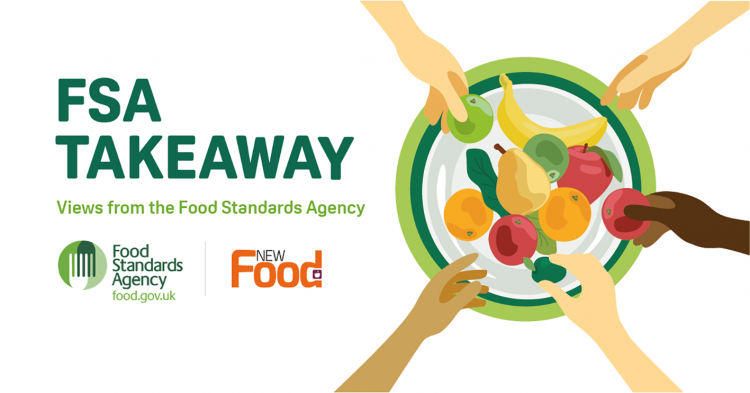Adapting to food delivery during lockdown
- Like
- Digg
- Del
- Tumblr
- VKontakte
- Buffer
- Love This
- Odnoklassniki
- Meneame
- Blogger
- Amazon
- Yahoo Mail
- Gmail
- AOL
- Newsvine
- HackerNews
- Evernote
- MySpace
- Mail.ru
- Viadeo
- Line
- Comments
- Yummly
- SMS
- Viber
- Telegram
- Subscribe
- Skype
- Facebook Messenger
- Kakao
- LiveJournal
- Yammer
- Edgar
- Fintel
- Mix
- Instapaper
- Copy Link
Posted: 14 January 2021 | Peter Quigley | No comments yet
Peter Quigley, Head of Chemical Safety Policy at the Food Standards Agency (FSA), informs businesses of the help the agency is providing to assist with the move many are having to make to takeaway and delivery services.


With the announcement of lockdowns across the UK since the new year, people are yet again being told to stay at home where possible to help limit the spread of COVID-19.
Hospitality venues such as cafes, restaurants, pubs, bars and social clubs must close, but can still provide food and non-alcoholic drinks for takeaway until 11pm, as well as click-and-collect and drive-through. All food and drink, including alcohol, can continue to be provided by delivery.
After the most trying of years for the hospitality sector, we are acutely aware of the pressures that restrictions continue to place on food businesses struggling to operate during the pandemic. As businesses adapt away from sit-in dining, we are here to help with the shift towards food delivery and distance selling.
While many businesses will have already changed their model towards food delivery during the initial restrictions last year, it’s important to note the different risks and requirements associated with food delivery that may not be immediately obvious to those used to a traditional dine-in set up.
Using our food safety for food delivery guidance will help to address these risks, protect customers and protect businesses. The guidance covers:
- Taking an order
- Hygiene guidance
- Allergen requirements
- Delivery instructions
- Delivery vehicle specifications
Alongside this, for those looking to switch to delivery during the COVID-19 pandemic, our changing your business model guidance sets out the steps businesses will need to take to ease this transition and ensure food safety remains a priority. The guidance covers:
- Informing your local authority
- Carrying out a risk assessment
- Selling food online
- Communicating with your customers
- Avoiding food crime
Switching to food delivery
Practical steps
When making the switch to food delivery, businesses should inform local authorities of any changes to registerable food activities. This does not necessarily mean that the local authority needs to re-inspect the business, but it keeps it informed of any changes that may introduce additional risks into your food production processes.
Any such changes to the business model should trigger a review and, where necessary, an update of the Hazard Analysis and Critical Control Point (HACCP) procedures. This may be in the form of the Safer food, better business pack or the Safe catering pack in Northern Ireland. A risk assessment should consider the impact of these changes to your usual hygiene and food safety practices.
An additional risk assessment is required to address the risks of COVID-19. The Health and Safety Executive has issued guidance on how to carry out a risk assessment and what to include.
Food hygiene
A risk assessment should address food hygiene risks that may be introduced by the switch to food delivery. It’s important to maintain good hygiene when it comes to cleaning, cooking, chilling and avoiding cross-contamination.
Remember to store food properly to keep it safe, which means storing food in sealed containers and at the correct temperature to protect it from harmful bacteria. This also stops objects falling into it and avoids cross-contamination with other ingredients, such as allergens.
Food safety
Businesses that are new to food delivery may not be aware of allergen requirements when taking an order online or by phone and providing food by delivery. If a restaurant is providing an online menu or order form, it must make sure it’s clear what it is selling, the quantity, the price, and include all the relevant allergen information.
Allergen information is required by law to be provided at two stages in the order process. Allergen information must be provided to customers:
- Before the purchase of the food is completed – this can be in writing (on a website, catalogue or menu) or orally (by phone)
- When the food is delivered – this can be in writing (allergen stickers on food or an enclosed copy of a menu) or orally (by delivery driver).
This is to protect customers with a food allergy and give confidence in the food that is being provided.
Food delivery from home
While the above information is relevant for existing food businesses, we are aware of many people who have responded to the pandemic by providing food from their own kitchen. Whether professional chefs looking for an income stream while their business is closed, or those looking to turn a passion into a career, providing food from a domestic kitchen poses additional safety risks which will need to be addressed to protect your customers. Anyone selling food from home must register as a food business.
Our starting a food business from home guidance sets out the practical start-up, food hygiene, food safety, food management and food delivery steps that need to be taken to start a successful and safe food business from home.
About the author
Peter Quigley is Head of Chemical Safety Policy at the Food Standards Agency. He joined the FSA in early 2020 from the Department for Exiting the European Union.
Related topics
Allergens, COVID-19, Food Safety, Hygiene, Outbreaks & product recalls, Packaging & Labelling, Pathogens, Recruitment & workforce, Regulation & Legislation, retail, Trade & Economy









